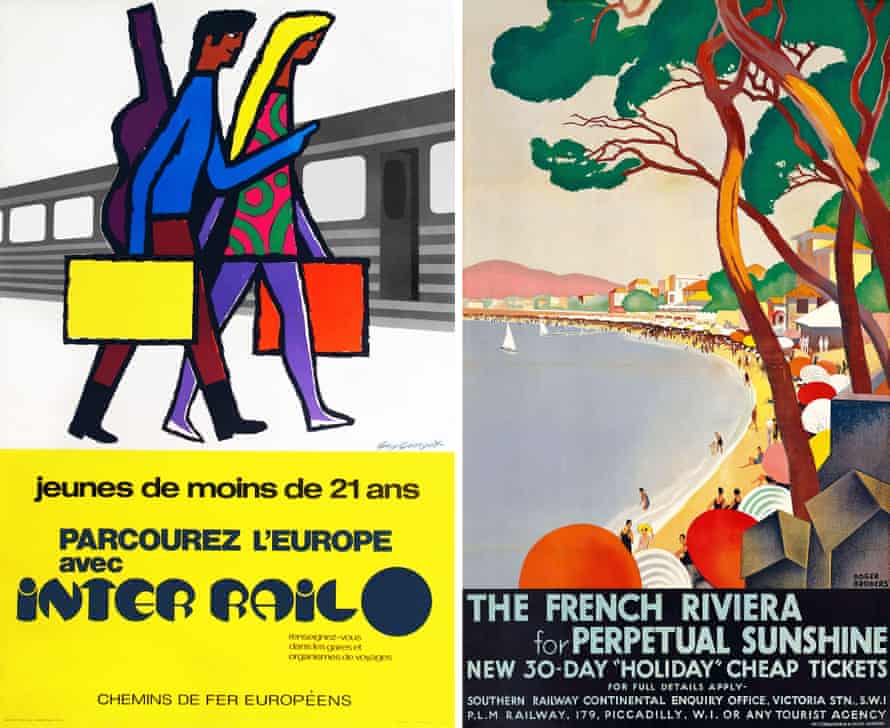
Images and Article from www.theguardian.com.
Observant Parisians at the city’s Gare de Lyon 50 years ago this month might have noticed a new type of traveller passing through the station. The well-heeled holidaymakers bound for the Riviera were there as usual. But now they were joined by the Interrail pioneers, all under 21 and more likely to be carrying backpacks than suitcases. They and their guitars were on the move, taking advantage of what was promoted as a one-off opportunity: pay £27.50 to explore Europe by train for a month.
In those days that freedom to roam was a privilege of youth. The first passes went on sale in March 1972, and the scheme was so successful that it became a regular offer and in time was opened to all. Fifty years on, Interrail passes are popular with travellers of all ages and the pioneers of 1972 are now drawing pensions.
Many of those spring travellers at the Gare de Lyon were en route to the Riviera, the older ones making a seasonal pilgrimage to Antibes, Nice, Juan-les-Pins or Menton. For the Interrail cohort, the journey mattered more than the destination, but would be all the better if at some stage they washed up in Saint-Tropez, newly propelled to prominence by the marriage of Mick and Bianca Jagger where the guestlist included Julie Christie and Brigitte Bardot.
The most illustrious daytime express to the Côte d’Azur was Le Mistral, with posh air-conditioned carriages (a rarity in 1972), two restaurant cars, ahairdressing salon and even a bookstall. But this wasn’t for the lowly young travellers: Interrail wasn’t accepted on many premium French trains.
So while the chic set sped south on Le Mistral (or the overnight Train Bleu), the youths with rucksacks and Interrail passes relied on slower trains. Some only made it to Mâcon or Montélimar. Others, demonstrating an enviable ability to sleep in overcrowded compartments – or even corridors – continued through the night to the Mediterranean.
The classic PLM route
These days, fast TGVs dash from Paris to Marseille in just over three hours, conveying both regular ticket-holders and Interrailers. For a modest supplement (usually €10 or €20) even the latter can nowadays speed to the Mediterranean in comfort.
But it is still possible to travel from Paris to the Mediterranean without recourse to the modern high-speed lines and see something of the French countryside by following instead the classic PLM railway taken by the Interrail pioneers half a century ago. PLM is shorthand for Compagnie des chemins de fer de Paris à Lyon et à la Méditerranée, and the route is doable with just one change of train, in Lyon, though some itineraries include additional changes at Dijon or Avignon.
PLM was the company that commissioned, from French illustrator Roger Broders, the posters that helped seal the Riviera in the public imagination. Though PLM had long been consigned to corporate history by 1972, the PLM route became a key artery for early pass holders.
Taking time for the ride south
The slower trains that still use the old PLM line out of Paris are not grand enough to command platform space at today’s Gare de Lyon. They are relegated to Paris Bercy, where there’s not a hint of Riviera romance on a dull November morning as I await the 07.33 to Lyon. This is not Le Mistral, but a humble French regional train with only second-class carriages. The train is comfy in a time-worn way and cyclists can take bikes for free. Its humbler pace affords more opportunities to engage with the passing landscape and get a feel for the distance travelled.

Soon we are slipping by the forests of Fontainebleau and following the Yonne Valley through pleasant countryside, pausing here and there at market towns. Shortly after stopping at Joigny, we slip under the high-speed line just as a TGV dashes by overhead. Now in the Armançon Valley, we pass Tanlay and Ancy before skirting Mont Auxois, where Julius Caesar defeated the Gallic tribes. Then we drop down steeply to reach the Ouche Valley and Dijon.
Two hours later, having seen a fine sweep of Burgundy grand cru vineyards, I alight in Lyon just as a TGV from Paris pulls in at an adjacent platform. That fast train has taken just two hours from Paris; my journey has taken five.
Slow travel is about making the most of the travelling. Shouldn’t we all occasionally take time out for a proper journey, one where the pleasure of the ride is not eclipsed by the anticipation of arrival? That’s why I broke the trip with an overnight stop in Lyon. On the way back north, I made it a three-day trip, with stops in Valence and Beaune.
Next morning, it’s another four hours on a similar regional train to Marseille, following the Rhône downstream from Lyon and name-checking vineyards on the way. There’s Côte Rôtie and Condrieu on the far side of the river, and soon we are slipping by Hermitage. Cement-grey skies give way to sunshine south of Valence, with Châteauneuf-du-Pape on the right and a distant view of Mont Ventoux far away to the left.
The one-way fare from Paris to Marseille via this old PLM route is about €115, which makes those first Interrail passes seem a bargain. And, as a journey with frequent stops along the way, this route really is perfectly suited to Interrail. No supplements, and just hop on and off as you please. Perhaps, as Europe marks 50 years of Interrail, 2022 is our chance to rediscover the exquisite pleasure of those slower journeys which were the backbone of so many early Interrail adventures.
To mark 50 years of Interrail, a 10% discount on global passes applies until 31 March 2022. Book online at allaboard.eu. Mobile passes bought during this promotion can be activated for use anytime up to 11 months after date of purchase. Adult global passes valid in more than 30 countries start at around €225, with discounts for seniors and youths. (No refund fee on unactivated passes if you decide not to travel.)
Nicky Gardner is co-author of Europe by Rail: the Definitive Guide. The 17th edition of the book is published in April 2022
Article shared from www.theguardian.com



